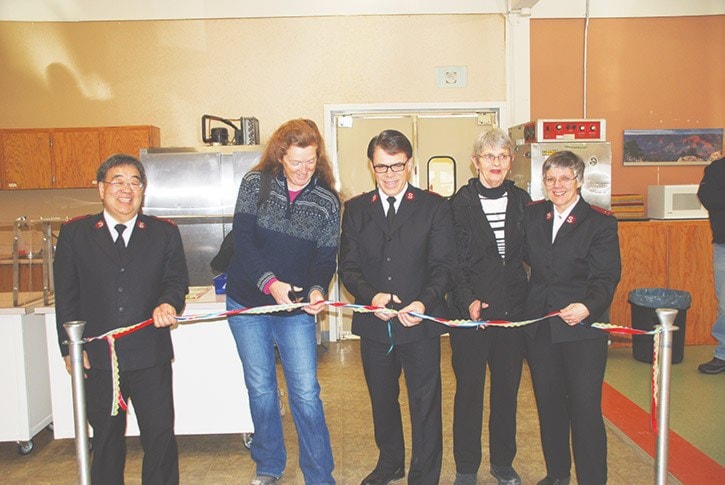The ribbon was cut to officially open the newly renovated kitchen at the Salvation Army community and family services building on Borland Street in Williams Lake Jan. 15.
What the Salvation Army thought would be an $88,000 project unfolded into a $380,000 project because of the increased volumes of people accessing the soup kitchen and the required upgrades.
“All of a sudden because of the volume of traffic coming through the building, we were told we had to upgrade the building to current codes,” Salvation Army Cpt. Claudine Kadonaga said, adding those costs also included new furnaces and duct systems.
Eliza Mitchell, a rancher from Tatlayoko Lake, is a director on the Garfield Weston Foundation, and a member of the Weston family. She was able to secure funding from the foundation — $185,000 — and the Salvation Army divisional headquarters contributed $150,000 toward the renovations.
“If we had to do it on our own, Williams Lake had run out of funds and it wouldn’t have happened,” Kadonaga explained.
Mitchell said her grandparents were the original ones to support the Salvation Army in Canada.
“They made the first donation in 1956 and have done so every year since,” she said.
Over the last three years, a total of $515,000 has been spent renovating the building, making an exercise room, a large activity centre, classrooms, small meeting rooms, a larger eating area, and larger food bank storage area.
It’s been suggested that the Salvation Army could have bought a building for the amount of money used for renovations, but Kadonago said there’s “no way” they could have found another building that would have suited their needs and provide the operating space required.
Operating on an annual budget of $696,783, for programming and 13 staff, the Salvation Army serves 2,000 individuals through the food bank.
Without its 45 to 50 volunteers, Kadonaga said the Salvation Army could not operate.
Outdated bread and produce arrives from local grocery stores.
“We’re reclaiming food that would have otherwise been thrown out,” Kadonaga added.
Non perishables come from local food drives, and every three to six weeks a truck load arrives from the Canada Food Bank Association, with foods she said are filler items such as cereal, cookies, personal hygiene items. They aren’t staples, but they help to augment hampers.
Present users of the food bank are 80 per cent on social assistance, 13 per cent on pension, and seven per cent working or on Employment Insurance.
Between 2007 and 2012, the Salvation Army saw a 1,000 per cent increase in service needs.
“A lot of that is not because the needs went up by 1,000 per cent, but with all the renovations and increase in staffing, we’ve got added ability to provide services to more people.”
In 2012, 456 new households accessed the service. People who used the food bank for the first time or were amalgamated because they moved into another house. The first two weeks of January have shown a 25 per cent decrease in the numbers of people receiving hampers compared to the same time period in 2012.
“That’s an encouraging picture,” Kadonago said, adding she’s hoping those first two weeks are an indication of the future.
“It would be great because unfortunately our donations over Christmas were down about 40 per cent for food items.”
Presently about 85 lunches are served Monday to Friday. In 2012 25,899 meals were served free of charge in the dining room, plus 30 lunches daily to needy students at Marie Sharpe elementary school.
Those meals and food bank distribution totalled a over $500,000 in food value, Kadonaga said.
“Not bad considering our food services budget, which includes the building and everything is $300,000.”
The thrift store generates $310,000 in sales, of which $115,000 is granted as a profit back to food services.
Kadonaga’s been asked if the food bank is sustainable and answered it’s not always a “hand out” but rather a “hand up.”
“It’s sustainable as long as we can give people a hand up,” she explained, adding spiritual and emotional development, drug and alcohol counselling, employment development, fitness, games, and craft programs, life skill classes, budgeting courses, and group meetings are some of the ways they try to meet that challenge.
With the new kitchen the plan is to offer basic line-cook training, as well as janitorial and retail merchandising training.
